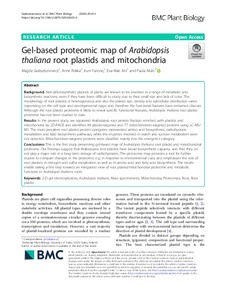Gel-based proteomic map of Arabidopsis thaliana root plastids and mitochondria
Grabsztunowicz Magda; Rokka Anne; Farooq Irum; Aro Eva-Mari; Mulo Paula
Gel-based proteomic map of Arabidopsis thaliana root plastids and mitochondria
Grabsztunowicz Magda
Rokka Anne
Farooq Irum
Aro Eva-Mari
Mulo Paula
Biomed Central Ltd.
Julkaisun pysyvä osoite on:
https://urn.fi/URN:NBN:fi-fe2021042821891
https://urn.fi/URN:NBN:fi-fe2021042821891
Tiivistelmä
Background Non-photosynthetic plastids of plants are known to be involved in a range of metabolic and biosynthetic reactions, even if they have been difficult to study due to their small size and lack of color. The morphology of root plastids is heterogeneous and also the plastid size, density and subcellular distribution varies depending on the cell type and developmental stage, and therefore the functional features have remained obscure. Although the root plastid proteome is likely to reveal specific functional features,Arabidopsis thalianaroot plastid proteome has not been studied to date. Results In the present study, we separated Arabidopsis root protein fraction enriched with plastids and mitochondria by 2D-PAGE and identified 84 plastid-targeted and 77 mitochondrion-targeted proteins using LC-MS/MS. The most prevalent root plastid protein categories represented amino acid biosynthesis, carbohydrate metabolism and lipid biosynthesis pathways, while the enzymes involved in starch and sucrose metabolism were not detected. Mitochondrion-targeted proteins were classified mainly into the energetics category. Conclusions This is the first study presenting gel-based map ofArabidopsis thalianaroot plastid and mitochondrial proteome. Our findings suggest that Arabidopsis root plastids have broad biosynthetic capacity, and that they do not play a major role in a long-term storage of carbohydrates. The proteomic map provides a tool for further studies to compare changes in the proteome, e.g. in response to environmental cues, and emphasizes the role of root plastids in nitrogen and sulfur metabolism as well as in amino acid and fatty acid biosynthesis. The results enable taking a first step towards an integrated view of root plastid/mitochondrial proteome and metabolic functions inArabidopsis thalianaroots.
Kokoelmat
- Rinnakkaistallenteet [27094]
